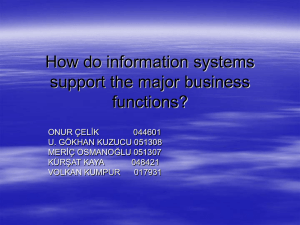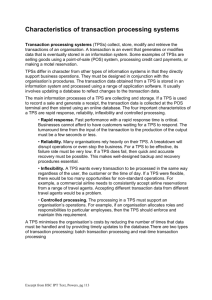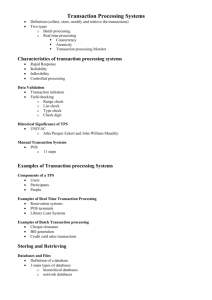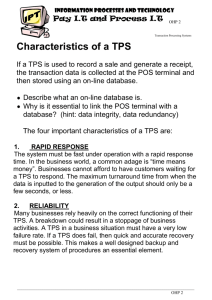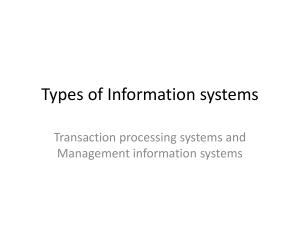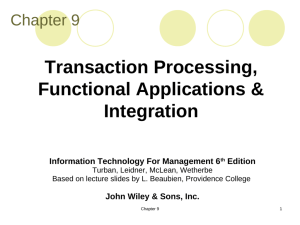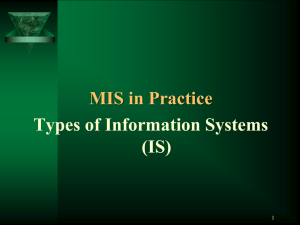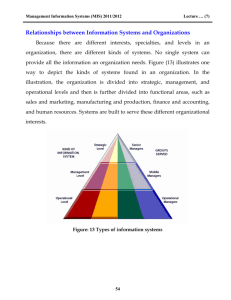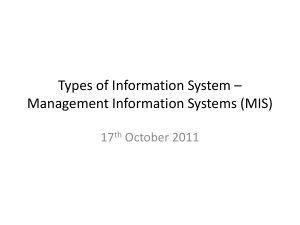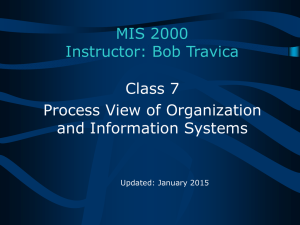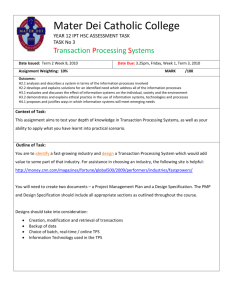วรวิทย์ พูลสวัสดิ์
advertisement
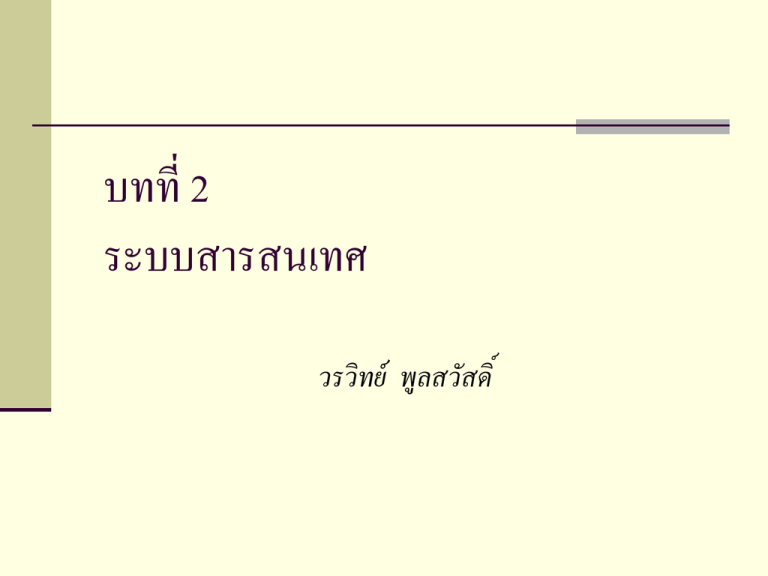
บทที่ 2 ระบบสารสนเทศ วรวิทย์ พูลสวัสดิ์ Review ระบบสารสนเทศ (Information system : IS) เป็ นระบบ หรือ องค์ประกอบต่างๆทีท ่ างานร่วมกันเพือ ่ ตอบสนองจุดประสงค์ ในการ รวบรวม (Collect)/ เข ้าถึงและปรับปรุง (Manipulated) / และ (disseminate) ข ้อมูลและข ้อสนเทศ(สารสนเทศ) และสร ้างผลตอบกลับเพือ ่ ให ้ได ้ผลตอบกลับตาม จุดประสงค์ 2 Review สารสนเทศ คือทรัพยากรทีเ่ ป็ นปั จจัยสาคัญมากอย่าง หนึง่ ในองค์กร ้ ทางธุรกิจจะ ใชระบบสารสนเทศเพื อ ่ เพิม ่ ผลตอบแทน (Revenues) และ ลดต ้นทน (reduce costsX 3 Information Concepts Data : Raw facts Information : Collection of facts organized in such a way that they have value beyond the facts themselves Process : Set of logically related tasks Knowledge : Awareness and understanding of a set of information 4 Data, Information, and Knowledge 5 What is an Information System? 6 Input, Processing, Output, Feedback Input Activity of gathering and capturing raw data Processing Converting data into useful outputs Output Production of useful information, usually in the form of documents and reports Feedback Information from the system that is used to make changes to input or processing activities Feedback is critical to successful operation of a system 7 ข้อสังเกตเกี่ยวกับคุณลักษณะของสารสนเทศ If an organization’s information is not accurate or complete People can make poor decisions, costing thousands, or even millions, of dollars Value of Information is depending on the type of data that user need Some characteristics become more valuable than others 8 The Value of Information Directly linked to how it helps decision makers achieve their organization’s goals Valuable information Can help people and their organizations perform tasks more efficiently and effectively 9 Computer-Based Information Systems Technology infrastructure Includes all hardware, software, databases, telecommunications, people, and procedures Configured to collect, manipulate, store, and process data into information 10 Business Information System Business information system are often integrated in some products or services and can be delivered by the same software package 11 Business Information Systems 12 The Development of Business Information Systems 13 Electronic and Mobile Commerce E-commerce : Any business transaction executed electronically between Companies (business-to-business, B2B) Companies and consumers (business-to-consumer, B2C) Consumers and other consumers (consumer-to-consumer, C2C) Business and the public sector Consumers and the public sector 14 Electronic and Mobile Commerce (continued) Mobile commerce (m-commerce) Transactions conducted anywhere, anytime E-commerce Can enhance a company’s stock prices and market value Electronic business (e-business) Uses information systems and the Internet to perform all business-related tasks and functions 15 Electronic and Mobile Commerce (continued) E-Business จะครอบคลุม E-Commerce เพราะใช้ท้ งั ระบสารสนเทศและเครื อข่ายอินเตอร์ เน็ต เพื่อทาธุรกรรมที่เกี่ยวข้องกับ ธุรกิจไม่วา่ จะเป็ นด้าน บัญชี การเงิน การตลาด การผลิต และ การ จัดการทรัพยากรมนุษย์ 16 Enterprise Systems: Transaction Processing Systems and Enterprise Resource Planning Transaction Any business-related exchange, such as payments to employees and sales to customers Transaction processing system (TPS) Organized collection of people, procedures, software, databases, and devices used to record completed business transactions 17 ระบบสารสนเทศแยกตามลักษณะการดาเนินงาน : TPS TPS เป็ นระบบที่ทาหน้าที่รวบรวมข้อมูลและประมวลผลเบื้องต้น ต้องมีคุณสมบัติของระบบสารสนเทศที่ดี ระบบ TPS มักจะเป็ นงานที่เกิดขึ้นประจารายวันเกิดบ่อยครั้ง เก็บ ข้อมูลที่จะมีผลต่อการเปลี่ยนแปลงต่อข้อมูลหลักของระบบ หน้าที่ ประมวลผลธุรกรรมเบื้องต้น จัดเก็บข้อมูลลงระบบฐานข้อมูลเพื่อนาไปใช้ประโยชน์ภายหลัง 18 แบบจาลอง TPS : Transaction Processing System 3 1 2 4 19 Enterprise Systems: Transaction Processing Systems อัตราค่าจ้างและชัว่ โมงการทางาน เป็ นข้อมูลนาเข้า (Input) ของ TPS ระบบ Payroll เพื่อสร้าง Pay Check 20 ลักษณะของ TPS 1. มักจะเป็ นระบบที่คนในองค์กรเป็ นผูน้ าเข้าข้อมูลเพื่อความ ถูกต้องของข้อมูล 2. เนื่องจากความก้าวหน้าทางเทคโนโลยี TPS บางระบบ สามารถให้ผใู ้ ช้ระบบที่เป็ นบุคคลภายนอกสามารถทาการนาเข้า ข้อมูลได้ 3. การประมวลผล TPS แบ่งเป็ น 2 ประเภทคือ 3.1 การประมวลผลแบบกลุ่ม (Batch Processing) 3.2 การประมวลผลทันที (Real time Processing) 21 Enterprise Systems: Transaction Processing Systems TPS Can speed business activities and reduce clerical costs Management information system (MIS) Organized collection of people, procedures, software, databases, and devices that Provides routine information to managers and decision makers 22 Enterprise Systems: Transaction Processing Systems หน้าที่ของ MIS คือ ใช้ขอ้ มูลจาก TPS ขององค์กรในการ ประมวลผลของระบบ 23 แบบจาลอง Management Information System TPS MIS 24 ประเภทรายงาน MIS Periodic Report : รายงานตามระยะเวลาที่กาหนด Summarize Reports : รายงานสรุ ป Exception Report : เป็ นรายงานที่จดั ทาเพื่อเงื่อนไขเฉพาะ On Demand Report : เป็ นรายงานที่ตอ้ งมี แต่ไม่มีกาหนดการ ใช้ที่แน่นอน 25 Traveler Plan Trip Receive Ticket Order Seats Available Airline Web Site NO Notify Traveler YES Check Flights NO Seats Available ? YES Reserve Seats Use Credit Card? NO NO YES Frequent Flyer Mileage Sufficient? YES Charge Credit Card Subtract Mileage Submit Ticket Order Charge OK? Receive e-Ticket NO Notify Traveler YES Confirm Flight(s) Issue e-Ticket 26 Question
